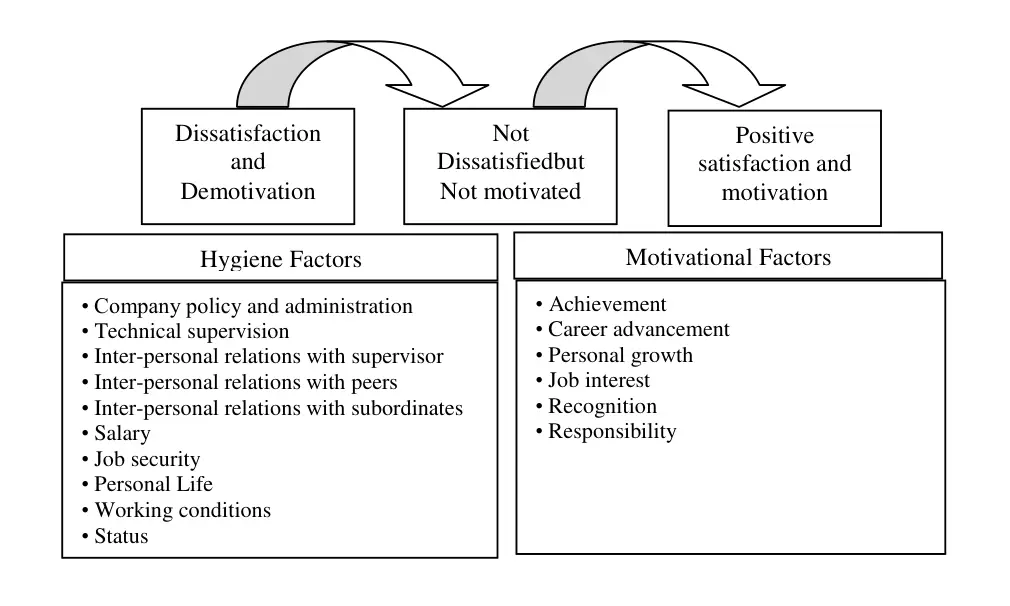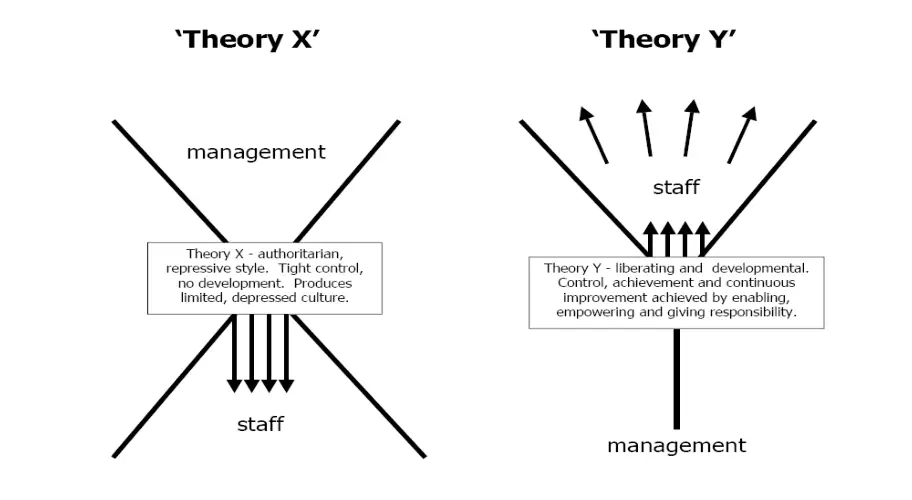Table of Contents
Theories of Motivation in Organisational Behaviour
These are the 4 main theories of motivation in organisational behaviour:
- Abraham Maslow’s Hierarchy of Needs Theory
- Frederick Herzberg’s Two-Factor Theory
- Douglas McGregor’s Theory X and Y
- Vroom’s Expectancy Theory

Abraham Maslow’s Hierarchy of Needs Theory
One of the most widely mentioned theories of motivation is the hierarchy of needs theory put forth by psychologist Abraham Maslow. Maslow saw human needs in the form of a hierarchy, ascending from the lowest to the highest, and he concluded that when one set of needs is satisfied, this kind of need ceases to be a motivator.

Physiological Needs
These are important needs for sustaining human life. Food, water, warmth, shelter, sleep, medicine, and education are the basic physiological needs that fall in the primary list of need satisfaction. Maslow was of the opinion that until these needs were satisfied to a degree to maintain life, no other motivating factors can work.
Security or Safety Needs
These are the needs to be free of physical danger and of the fear of losing a job, property, food, or shelter. It also includes protection against any emotional harm.
Since people are social beings, they need to belong and be accepted by others. People try to satisfy their need for affection, acceptance, and friendship.
Esteem Needs
According to Maslow, once people begin to satisfy their need to belong, they tend to want to be held in esteem both by themselves and by others.
This kind of need produces such satisfaction as power, prestige status, and self-confidence. It includes both internal esteem factors like self-respect, autonomy, and achievements and external esteem factors such as states, recognition, and attention.
Need for Self-Actualization
Maslow regards this as the highest need in his hierarchy. It is the drive to become what one is capable of becoming, it includes growth, achieving one’s potential, and self-fulfillment. It is to maximize one’s potential and to accomplish something.
Frederick Herzberg’s Two-Factor Theory
Frederick has tried to modify Maslow’s need Hierarchy theory. His theory is also known as the Two-factor theory or Hygiene theory. He stated that there are certain satisfiers and dissatisfied for employees at work.

Intrinsic factors are related to job satisfaction, while extrinsic factors are associated with dissatisfaction. He devised his theory on the question: “What do people want from their jobs?” He asked people to describe in detail, such situations when they felt exceptionally good or exceptionally bad.
From the responses that he received, he concluded that the opposite of satisfaction is not dissatisfaction. Removing dissatisfying characteristics from a job does not necessarily make the job satisfying.
He states that the presence of certain factors in the organization is natural and the presence of the same does not lead to motivation. However, their non-presence leads to de-motivation. In a similar manner, there are certain factors, the absence of which causes no dissatisfaction, but their presence has a motivational impact.
According to the two-factor theory, there are four possible combinations;
- High Hygiene + High Motivation
- High Hygiene + Low Motivation
- Low Hygiene + High Motivation
- Low Hygiene + Low Motivation
High Hygiene + High Motivation
The ideal situation is where employees are highly motivated and have few complaints.
High Hygiene + Low Motivation
Employees have few complaints but are not highly motivated. The job is viewed as a paycheck.
Low Hygiene + High Motivation
Employees are motivated but have a lot of complaints. A situation where the job is exciting and challenging but salaries and work conditions are not up to par.
Low Hygiene + Low Motivation
This is the worst situation where employees are not motivated and have many complaints. Unkile Maslow, who offered little data to support his ideas, Herzberg and others have presented considerable empirical evidence to confirm the motivation-hygiene theory, although their work has been criticized on methodological grounds.
Douglas McGregor’s Theory X and Y
McGregor, in his book “The Human Side of Enterprise,” states that people inside the organization can be managed in two ways. The first is basically negative, which falls under category X, and the other is basically positive, which falls under category Y.
After viewing the way in which the manager dealt with employees, McGregor concluded that a manager’s view of the nature of human beings is based on a certain grouping of assumptions and that he or she tends to mold his or her behavior towards subordinates according these assumptions.

Theory X
Under the assumptions of theory X:
- Employees inherently do not like work and whenever possible, will attempt to avoid it.
- Because employees dislike work, they have to be forced, coerced, or threatened with punishment to achieve goals.
- Employees avoid responsibilities and do not work fill formal directions are issued.
- Most workers place greater importance on security over all other factors and display little ambition.
Theory Y
In contrast under the assumptions of theory Y:
- The physical and mental effort at work is as natural as rest or play.
- People do exercise self-control and self-direction if they are committed to those goals.
- Average human beings are willing to take responsibility and exercise imagination, ingenuity, and creativity in solving the problems of the organization.
- That the way things are organized, the average human being’s brainpower is only partly used.
On analysis of the assumptions it can be detected that theory X assumes that lower-order needs dominate individuals and theory Y assumes that higher-order needs dominate individuals. An organization that is run on Theory X lines tends to be authoritarian in nature, the word “authoritarian” suggests such ideas as the “power to enforce obedience” and the “right to command.”
In contrast, Theory Y organizations can be described as “participative”, where the aims of the organization and of the individuals in it are integrated; individuals can achieve their own goals best by directing their efforts towards the success of the organization.
Vroom’s Expectancy Theory
The most widely accepted explanation of motivation has been propounded by Victor Vroom. His theory is commonly known as the expectancy theory.
The theory argues that the strength of a tendency to act in a specific way depends on the strength of an expectation that the act will be followed by a given outcome and on the attractiveness of that outcome to the individual make this simple, expectancy theory says that an employee can be motivated to perform better when there is a belief that the better performance will lead to good performance appraisal and that this shall result into the realization of personal goal in form of some reward. Therefore;
Motivation = Valence x Expectancy

FAQs Section
What are the theories of motivation in organisational behaviour?
These are the 4 theories of motivation in organisational behaviour:
1. Abraham Maslow’s Hierarchy of Needs Theory
2. Frederick Herzberg’s Two-Factor Theory
3. Douglas McGregor’s Theory X and Y
4. Vroom’s Expectancy Theory.
